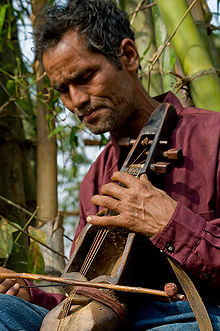- Sarangi (Nepali)
-
The Sarangi (Nepali/Hindi: सारङ्गी) is a folk Nepalese string instrument. Unlike Classical Indian Sarangi, it has four strings and all of them are played. Traditionally, in Nepal, Sarangi was only played by people of Gandarva or Gaine cast, who sings narrative tales and folk song.[1] However, in present days, its widely used and played by many.
Sarangi Mechanics
Traditional Nepali Sarangi is made up of single piece of wood having a neck and hollowed out body. Sarangi is carved out from a very light wood, locally known as Khiro. The body is carved into a hollow frame with two openings. The lower opening is then covered up with dried sheep-skin. The original strings were made out of sheep intestine, similar to the use of catgut (made from the intestines of cattle) in violins. The village people allotted intestines of sheep, sacrificed during major festivals like Dasain, to the Gandarvas. The Gandarvas left the intestine in a pot for some days. Once the meat was fully rotten, it was pulled out, leaving behind the fine nerves of the intestine which were then woven to get the strings, which produced fine quality sound.[2] However these days, readily available nylon and steel strings are more popular with Sarangi players as they do not have the time to prepare the traditional variety of strings.
It is available in various size. Sarangi has four strings and played with the help of a bow. Horse-tail hair, which is still used by violin players, was originally used for the bow string of the Sarangi but these days nylon strings are common. The strings are supported by two bridges and tuned by Kunti (tuner). The Sarangi’s neck is fretless and the bridge is seated on a skin stretched over the body of the instrument. Different notes are made by touching the strings with the nail of fingers of the left hand. Notes in traditional sarangi strats from G4 and almost covers two octaves. Traditionally, sarangi is tuned as G4 C5 C5 G5 or Pa Sa Sa Pa.
References
Categories:- String instruments
- Nepalese musical instruments
Wikimedia Foundation. 2010.


